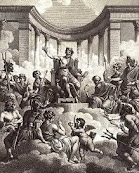

 Título: Teatro de Caesar Augusta.
Título: Teatro de Caesar Augusta.
Material y técnica: Hormigón
Emplazamiento: Zaragoza
Dimensiones: desconocidas
Contexto histórico: es un teatro de la época romana construido en la primera mitad del siglo I d.C durante los gobiernos de Tiberio y Claudio en Caesar Augusta . Tenía capacidad para unos seis mil espectadores y seguía el modelo del teatro Marcelo de Roma.
Restauración: se empezó a restaurar en el año 1974. La restauración duró 3 años.
________________________________________________________________
Title:Theatre of Caesar Augusta
Material:concrete
Location: Zaragoza
Dimensions: unknown
Historical context: it's a theatre of the roman epoch. It was built in the first part of the sicle I a.J.Ch while Tiberio and Claudio were governing in Caesar Augusta.It had capacity to keep 6000 spectators and it seemed like Marcelo Theatre in Rome.
Restauration:it was started to restor in 1974. The restauration lasted 3 years.
Nombre: Casa del triunfo de Baco
Dónde fué hecho y encontrado: Casa de Peristilo
Cuándo:comienzos del siglo XX
Descripción: Vistoso emblema con el dios blandiendo el tirso en carro tirado por dos tigresas uncidas por un yugo, evocando su regreso triunfante de la India. Un cortejo de sateros y vacantes, la victoria que acompaña al dios y la niña con adornos florales. Baco viste una túnica y paralis al hombro y se corona la cabeza con ojas alargadas. Baco, asociado a la orgía y al éxtasis, y como dios de la fecundidad, aseguraba la salvación en el más allá.
Temática: decoración
Dónde se expone actuallmente: Museo Arqueológico Nacional de Madrid.
_________________________________________________________________
Name: The House of Baco's Triumph
Where was made and found: Peristilo's house
When: first part of siecle XX
Description: Emblem with the god showing the body in chariot thrown by two tigresses, evoking his return victorious of the India.A group of satyrs and the victory that accompanies the god and the girl on floral adornments. Baco dresses a tunic and the head is crowned with leafs lengthened. Baco associated with the orgy and with the ecstasy, and as god of the fecundity, he was assuring the salvation in beyond.
Thematic: decoration
Actually you can see it in: Museum Archaeological National of Madrid
 Nombre: cabeza de escultura.
Nombre: cabeza de escultura.
Material: marmol de Paros (Grecia).
Donde se encontró : Zaragoza.
Cuando se hizo : segundo tercio del siglo I.
Dimensiones: tamaño superior del natural.
Descripción: representa a una joven princesa de la familia Julio-Claudia.
Temática: decoración.
Donde se expone ahora: Teatro Romano de Zaragoza.
____________________________________________________________________
Name: sculpture's head
Material : marble of Paros ( Greece)
Where was found : Zaragoza
When was made: the second third of siecle I
Dimensions: bigger than real-size
Description: represent a young princess of the Julio-Claudia family.
Thematic: decoration
Actually you can see it in : the Roman Theatre of Zaragoza.

Nombre: muñeca de marfil.
Material: marfil.
Dónde fue encontrado: Zaragoza.
Dimensiones: 50 cm.
Descripción: muñeca de marfil vestida con trapos azules que servía como metodo de entretenimiento para las niñas en la época romana; lo que vendría a ser Barbie en nuestro tiempo.
Temática: vida cotidiana.
Dónde se exhibe ahora: en el Foro Romano de la ciudad de Zaragoza.
______________________________________________________________________
Name: ivory doll
Material: ivory
Where was found: Zaragoza
Dimension: 50 cm.
Description: an ivory doll wearing blue clothes that was used to make kids have fun in Roman Time. It was like a kind of Barbie in our time.
Thematic: daily life.
Actually you can see it in: in the Roman Forum of Zaragoza.

Nombre: Ascos con Atalanta e Hipómenes.
Material: cerámica.
Técnica: técnica de figuras rojas.
Dónde fue hecho y encontrado: Sicilia
Cuándo: primer cuarto del siglo IV a.C
Descripción: representacion de la competición entre Atalanta e Hipómenes, el valiente joven que la venció con las manzanasa que le había entregado Afrodita: al recoger Atalanta las que el joven dejaba caer le aventajó. Zeus los convirtio en león después de su boda,en el pensamiento griego se creia que estos animales no se cruzaban entre sí, con lo que les abocaba a la soledad.También condeno a tirar del carro de la diosa Cibeles.
Temática: mitología con relación al deporte.
Dónde se exhibe ahora:Madrid
____________________________________________________________________
Name :Ascos with Atalanta and Hipómenes
Material:ceramic
Technique:technique of red figures 0
Where was made and found:Sicily
When:first part of siecle IV b.J.C
Description: Representation of the competition between Atalanta and Hipomenes; the brave young beat her with the apples that Afrodita brought him. She was picking up the apples that he let fall at the floor and had made him the win. Zeus transformed both of them in lions after his wedding, greek people thought that those animals were solitaries, so he sentenced them to stay in solitude. He also sentenced them to pull of Cibeles chariot.
Thematic: mitology with sport relation
Actually you can see it in: Madrid





